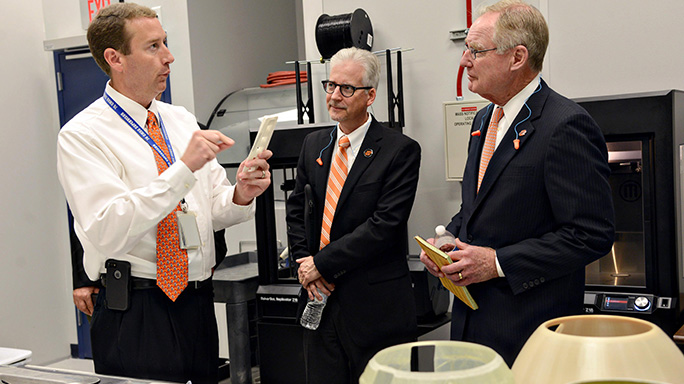The following is a release from John Parker, Tinker Air Force Base Public Affairs:
The Oklahoma City Air Logistics Complex is finalizing a strategic plan to integrate 3-D printing technology into nearly every aspect of its airpower sustainment mission.
OC-ALC experts foresee 3-D printing, also called additive manufacturing, filling needs ranging from making aircraft engine parts to printing electronic components designed by the 76th Software Maintenance Group.
Advertisement — Continue Reading Below
- RELATED STORY: US Army Looking Into 3-D Printers For Food
“We’ve realized that additive manufacturing is a technology that is mature enough, that it is being adopted very strongly in industry right now, and that we as a depot need to build this capability,” said Dr. Kristian Olivero, the complex’s top scientist and engineer.
“This is a step-change technology that will really change in some ways how we can do depot maintenance,” Olivero continued. “It will give us a lot of speed and flexibility, but it’s something that we have to learn to manage and understand how to use.”
The OC-ALC’s plan stems from the additive manufacturing goals in the Air Force’s “Complex of the Future” strategic forecast for the coming decades. Similar complex-specific initiatives are underway at the air logistics complexes at Robins Air Force Base, Georgia, and Hill AFB, Utah.
Advertisement — Continue Reading Below
Additive manufacturing machines build objects from raw materials fed into them. Plastic filament that looks like thick fishing line, for example, can be fed into a 3-D printer to construct an object layer by layer on a platform. A growing list of other raw materials includes metal pellets, ceramics and gypsum.
Olivero, the complex’s technical director, said the potential impact of additive manufacturing on depot operations is significant. Replacement engine parts, for example, that are currently bought, shipped to the depot, stored in inventory and pulled when needed could instead be printed on demand directly at repair and overhaul sites as 3-D printing advances.
The Air Force’s oldest planes, such as the venerable B-52 Stratofortress, often need parts that haven’t been manufactured for decades. Using 3-D laser mapping and other techniques, existing parts can be reverse engineered, and even improved, at air maintenance depots.
Advertisement — Continue Reading Below
“The speed of it and the flexibility of it will very much improve our industrial base, where we’re repairing aircraft that are getting older and older,” Olivero said. “We have more and more instances of parts that we can’t get. All of this will help us be a better logistics center.”
Engineers designing new or improved parts could also get their final products out more rapidly. Traditional lathe machining, a subtractive process that carves parts out of blocks of material, can take months of machining time if a complex part needs multiple prototypes before it’s perfected, Olivero said.
“With additive manufacturing, that part may take a couple of hours to print and you can actually go through five or six iterations in days,” Olivero said. “Even if your final part is going to be machined, you can print it in plastic five times to make sure it’s got the correct geometries, the right tolerances, the correct interfaces, and then machine the final one.”
Advertisement — Continue Reading Below
Additive manufacturing also has disadvantages in some cases, Olivero said. Some jet engine components must withstand extremely high temperatures and physical stresses. Parts milled traditionally from a block of forged titanium, for example, tend to have better molecular properties for that job than an identical 3-D-printed titanium part.
“For metals in particular, the additive manufactured properties are typically somewhat lower, so what you gain in speed and flexibility, you lose some mechanical properties,” Olivero said. “You can get good characteristics compared to 10 or 20 years ago, but it’s not as good yet.”
The scope of the strategic plan, scheduled to be completed in the coming months, is broad and will cover questions such as how to build engineers’ expertise with 3-D printing and what to do with troves of 3-D computer models that will be created.
Advertisement — Continue Reading Below
“We know how to manage 2-D models,” Olivero said. “We have files of paper drawings. We have technical orders with drawings in them. Now we have to figure out how to store, classify, maintain and configure all of those 3-D models.
“It’s a completely different paradigm,” Olivero said. “There are new challenges, new processes and new capabilities, and we need to work out how to make all that work together for our benefit.”
According to Jamie Gilbert, the OC-ALC industrial process authority, “The biggest challenge is going to be changing the mentality of our engineering and technician workforce because right now most of the people in the complex aren’t used to additive manufacturing and working with 3-D models to manufacture parts and to design repairs.
Advertisement — Continue Reading Below
“Even many of our young engineers who were just out of college four or five years ago, it’s mostly new for them,” Gilbert continued. “We’re going to have to learn how to incorporate it and insert it into our manufacturing machine.”
























